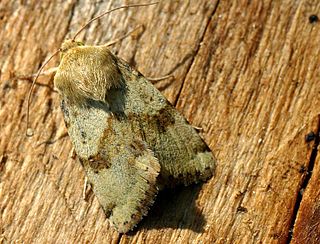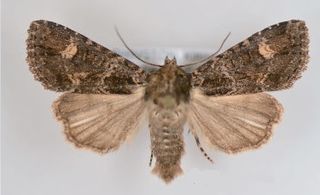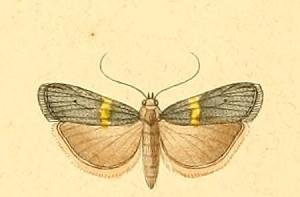
Melitaea diamina, the false heath fritillary, is a butterfly of the family Nymphalidae.

Heliothis viriplaca, the marbled clover, is a moth of the family Noctuoidea. It is found in Europe and across the Palearctic to Central Asia then to Japan, Korea and Sakhalin. In the south, it penetrates to Kashmir and Myanmar. As a migratory moth, it also reaches areas in northern Fennoscandia in some years. North of the Alps, both indigenous and immigrant individuals occur in certain areas. The heat-loving species occurs mainly on dry grasslands, fallow land, heathlands and sunny slopes and slopes and the edges of sand and gravel pits.

Xanthia togata, the pink-barred sallow, is a species of moth of the family Noctuidae. It is a Holarctic species, and is found throughout Europe and east through the Palearctic to Central Asia, and Siberia up to the Ussuri. The distribution area includes the United States and Canada. It was first described by the German entomologist Eugenius Johann Christoph Esper in 1788 from the type specimen in Germany

Cataclysta lemnata, the small china-mark, is a moth species of the family Crambidae. It is found in Europe, Morocco and Iran.

Anania stachydalis is a species of moth of the family Crambidae. It is found in Europe. The species closely resembles Anania coronata.

Calliteara pudibunda, the pale tussock, is a moth of the family Erebidae. The Dutch common name for the moth (Meriansborstel) comes from the butterfly and insect painter Maria Sibylla Merian. The species was first described by Carl Linnaeus in his 1758 10th edition of Systema Naturae. It is found in Asia and Europe.

Euchromius ocellea, the necklace veneer or belted grass-veneer, is a cosmopolitan migratory species of moth of the family Crambidae, first described by Adrian Hardy Haworth in 1811. It has Hodges number 5454.

Catocala nymphagoga, the oak yellow underwing, is a moth of the family Erebidae. It is found in Southern Europe, from Bulgaria up to the Iberian Peninsula and sometimes further north as a migrant. It is also found in North Africa and Asia Minor.

Aseptis binotata, the rusty shoulder knot moth, is a moth of the family Noctuidae. The species was first described by Francis Walker in 1865. It is found widespread in western North America, west of south-central Alberta, Wyoming, and Nebraska. Along the Pacific Coast it occurs from northern Mexico to south-central British Columbia. It can be found from sea level to altitudes over 2000 meters in a variety of habitats from dense forest to shrub desert.

Zealandopterix zonodoxa is a moth of the family Micropterigidae. It endemic to New Zealand and is found from the Hawkes Bay north as well as on Poor Knights, Little Barrier and Great Barrier Islands. It is the smallest micropterigid in New Zealand and the shiny white markings on the forewing of this species are variable. It is a day flying moth, but has been collected using UV light. Adults are on the wing from September to March and the species has been witnessed visiting the flowers of Nikau and Cordyline pumilio in large numbers. It inhabits a wide variety of moist indigenous forest but is associated with forests in which podocarps are common. Larvae have been sieved from rotten wood on the floor of a mixed podocarp/broadleaf forest or extracted from moss or from bryophytes.

Oxybia is a monotypic snout moth genus described by Hans Rebel in 1901. Its only species, Oxybia transversella, was described by Philogène Auguste Joseph Duponchel in 1836. It is found in southern Europe and on the Canary Islands.

Ichneutica nullifera is a moth of the family Noctuidae. This species is endemic to New Zealand and can be found in the Tongariro National Park, along the Wellington coast and throughout the South Island. The adults are large and the forewing of adults can vary in colour from pale fawn to dark grey. The larvae are coloured a bright yellow-brown with a paler underside. The larval host species are in the genus Aciphylla and as a result the adult moths are often found in habitat dominated by species in this genus. Adults are on the wing from November to early April and are sometimes attracted to light.

Cnephasia longana, the omnivorous leaftier moth, long-winged shade or strawberry fruitworm, is a moth of the family Tortricidae. It was described by Adrian Hardy Haworth in 1811. It is native to western Europe. It is an introduced species in western North America. The species has also been reported from north-western Africa and Asia. The habitat consists of downland and rough ground.
Prolita deoia is a moth of the family Gelechiidae. It was described by Ronald W. Hodges in 1966. It is found in North America, where it has been recorded from California.
Prolita maenadis is a moth of the family Gelechiidae. It was described by Ronald W. Hodges in 1966. It is found in North America, where it has been recorded from California.
Prolita barnesiella is a moth of the family Gelechiidae. It was described by August Busck in 1903. It is found in North America, where it has been recorded from California, Colorado, Arizona, New Mexico, Texas, Wyoming and Utah.
Prolita rectistrigella is a moth of the family Gelechiidae. It was described by William Barnes and August Busck in 1920. It is found in North America, where it has been recorded from California, Arizona, New Mexico, Colorado, Utah, Wyoming, Montana, Washington and Alberta.

Aseptis fanatica is a moth of the family Noctuidae first described by Tomas Mustelin in 2006. It is found in western North America in Washington, Oregon, California, and Baja California Norte in Mexico. It is found in habitats like brush land and open forest in southern California, mostly at 1000–2000 meters, but occurs at lower elevations farther north.

Neopalpa donaldtrumpi is a moth species of the genus Neopalpa occurring in Southern California and Northern Mexico. It was described in 2017 by Iranian-Canadian scientist Vazrick Nazari. Known for its yellowish-white head scales being reminiscent of Donald Trump's hair, the moth was given its name because Nazari stated that he wanted "to bring wider public attention to the need to continue protecting fragile habitats in the US that still contain many undescribed species."

Epinotia abbreviana is a moth of the family Tortricidae. It is found in Europe and was first described by Johan Christian Fabricius in 1794.














